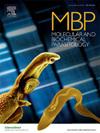重新审视“核选项”:确认Ss-daf-12在粪圆线虫和其他寄生线虫感染中的功能和治疗潜力。
IF 1.4
4区 医学
Q4 BIOCHEMISTRY & MOLECULAR BIOLOGY
引用次数: 2
摘要
寄生线虫感染性第三期幼虫(L3i)的形态发生和发育机制与秀丽隐杆线虫(Caenorhabditis elegans)的发育机制类似。Dauer调节信号转导包括在amphidial复合体的化学感觉神经元中的初始G蛋白偶联受体(GPCR)信号传导,该信号传导调节组织中平行的胰岛素和tgf β样信号传导。胰岛素和tgf β样信号通过核受体(NR) DAF-12汇聚共同调节类固醇信号。DAF-12类固醇配体的发现为秀丽隐杆线虫的小分子生理学研究开辟了新的途径。这些信号通路在寄生线虫中是保守的,越来越多的证据支持它们在土壤传播物种感染过程中对L3i的形成和发育调节中起作用。本文简要介绍了G蛋白偶联受体(GPCR)、胰岛素和tgf β样信号传导的证据,并主要关注DAF-12的寄生虫同源物的信号传导。我们深入讨论了利用敏感的分析技术鉴定Δ7-dafachronic酸是粪便圆形线虫和弯曲血蜱的DAF-12同源物的天然配体,并利用CRISPR/Cas9靶向诱变赋予NR Ss-DAF-12、其辅激活剂Ss-DIP-1和关键配体生物合成酶Ss-CYP-22a9类似的调控功能。最后,我们发表了Ss-DAF-12信号作为人类圆线虫病化疗靶点的潜在证据。本文章由计算机程序翻译,如有差异,请以英文原文为准。
The 'Nuclear Option' Revisited: Confirmation of Ss-daf-12 Function and Therapeutic Potential in Strongyloides stercoralis and Other Parasitic Nematode Infections.
Mechanisms governing morphogenesis and development of infectious third-stage larvae (L3i) of parasitic nematodes have been likened to those regulating dauer development in Caenorhabditis elegans. Dauer regulatory signal transduction comprises initial G protein-coupled receptor (GPCR) signaling in chemosensory neurons of the amphidial complex that regulates parallel insulin- and TGFβ-like signaling in the tissues. Insulin- and TGFβ-like signals converge to co-regulate steroid signaling through the nuclear receptor (NR) DAF-12. Discovery of the steroid ligands of DAF-12 opened a new avenue of small molecule physiology in C. elegans. These signaling pathways are conserved in parasitic nematodes and an increasing body of evidence supports their function in formation and developmental regulation of L3i during the infectious process in soil transmitted species. This review presents these lines of evidence for G protein-coupled receptor (GPCR), insulin- and TGFβ-like signaling in brief and focuses primarily on signaling through parasite orthologs of DAF-12. We discuss in some depth the deployment of sensitive analytical techniques to identify Δ7-dafachronic acid as the natural ligand of DAF-12 homologs in Strongyloides stercoralis and Haemonchus contortus and of targeted mutagenesis by CRISPR/Cas9 to assign dauer-like regulatory function to the NR Ss-DAF-12, its coactivator Ss-DIP-1 and the key ligand biosynthetic enzyme Ss-CYP-22a9. Finally, we present published evidence of the potential of Ss-DAF-12 signaling as a chemotherapeutic target in human strongyloidiasis.
求助全文
通过发布文献求助,成功后即可免费获取论文全文。
去求助
来源期刊
CiteScore
2.90
自引率
0.00%
发文量
51
审稿时长
63 days
期刊介绍:
The journal provides a medium for rapid publication of investigations of the molecular biology and biochemistry of parasitic protozoa and helminths and their interactions with both the definitive and intermediate host. The main subject areas covered are:
• the structure, biosynthesis, degradation, properties and function of DNA, RNA, proteins, lipids, carbohydrates and small molecular-weight substances
• intermediary metabolism and bioenergetics
• drug target characterization and the mode of action of antiparasitic drugs
• molecular and biochemical aspects of membrane structure and function
• host-parasite relationships that focus on the parasite, particularly as related to specific parasite molecules.
• analysis of genes and genome structure, function and expression
• analysis of variation in parasite populations relevant to genetic exchange, pathogenesis, drug and vaccine target characterization, and drug resistance.
• parasite protein trafficking, organelle biogenesis, and cellular structure especially with reference to the roles of specific molecules
• parasite programmed cell death, development, and cell division at the molecular level.

 求助内容:
求助内容: 应助结果提醒方式:
应助结果提醒方式:


